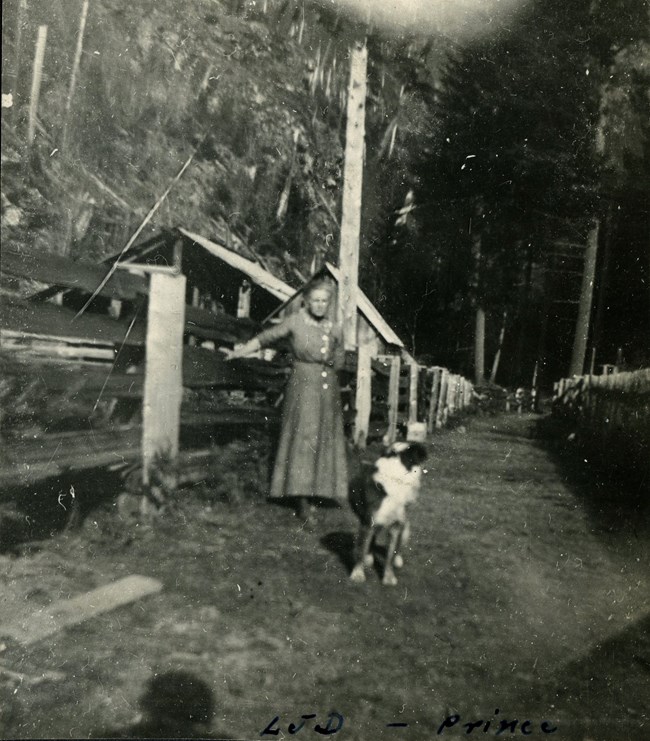Part of a series of articles titled Women's History in the Pacific West - Columbia-Pacific Northwest Collection.
Previous: Leona Woods Marshall Libby
Article

Davis Family Collection, North Cascades National Park archives.
The life of Lucinda J. Davis and her family is intertwined with the North Cascades region. Her love of the wilderness and desire for independence drew her to the region in the late nineteenth century.1 It was a place for a divorced mother to start over, developing two homesteads, one near Marblemount on the Cascade River and another along the Skagit River at Cedar Bar near the current town of Diablo. As in much of the late-nineteenth-century American West, it was also a place for white female entrepreneurship, providing services for the single men who came as part of US imperialist expansion and settlement in the region.
Davis was born in 1852 in Preston, Pennsylvania to Juliette A. Tallman and George W. Leach, a Methodist minister.2 In her twenties, she worked as a school teacher, married Etsyl Clum Davis, and moved to Milford, Nebraska.3 During the 1880s, two of Lucinda Davis’s brothers, George and Will Leach, migrated to the North Cascades region to stake claims along the Cascade River.4 When George drowned in a canoe accident in 1890, Will wrote to encourage her to come and take up his claim on the river. Recently divorced and living in Colorado, Davis gathered up her three children, Frank (13), Idessa (8), and Glee (5), and made the journey to Washington, travelling by train, boat, wagon, and foot.5 Within two years, they had cleared enough land to plant a small garden with a variety of vegetables and grains; they grew raspberries, had a cow for milk, and raised chickens. During the summers of 1893 and 1895, Davis and her family ran a small store and hotel at Goodell’s Landing while the regular operators of the hotel were off prospecting for gold; many customers were themselves passing through to get to the gold fields.6 During the winter months, Davis would go down river to Mount Vernon or Sedro-Woolley with their animals to keep them out of the harsh winter conditions and so her children could attend school. In 1897, a flood ruined most of their homestead along the Cascade River.7 The family built a new homestead at Cedar Bar and relocated there in June 1898. Within days, Davis was running a business feeding travelers.8
The Davis Ranch became a popular stopover for gold miners and other travelers. Located in a prime location along the Skagit River, the ranch served fresh milk, home-grown vegetables and fruit, and homemade fruit pies. They also provided beds for those who needed to stay overnight.9 In 1900, two guests burned the Davis house down (it was not clear it if was an accident or arson), and the family constructed a larger building within a year. By 1903, their guestbook recorded over 400 customers a year. Because of their success, they built a new house on the property in 1907 and hung a sign above the porch that read: “Davis Ranch-Meals and Beds.”10 By 1917, the ranch had 11 rooms supplied with electricity from a dam and water flume constructed by the Davis sons.11 During the 1920s, a traveler described the roadhouse as a “mecca in the wilderness of gaunt mountain crags, evergreen forests, and ‘white water.’ There are…electric lights, a comfortable farmhouse built of hand-hewn lumber.”12 In addition to running her roadhouse, Davis loved to explore the peaks around her. In 1911 she, along with Hazel Campbell (her future daughter-in-law) climbed what is now known as Pyramid Peak, and Sourdough Mountain, the first white women to reach the summits of these peaks.13
Davis had to negotiate with the US Forest Service for many years to retain her homestead claim, as the ownership of the land was contested. She finally got the full title to her land signed in 1917. During the 1920s, Seattle City Light wanted to develop hydroelectric projects in the area of her roadhouse and condemned her property in 1928. Davis fought City Light two times in court, but ultimately lost and sold her homestead in 1929.14 Davis lived the rest of her life with her son Glee and his family. She died in their home in Sedro-Woolley in June 1931.15 Though Davis had to leave her roadhouse, her family’s imprint on the area is memorialized in Davis Peak, near Diablo.16
Part of a series of articles titled Women's History in the Pacific West - Columbia-Pacific Northwest Collection.
Previous: Leona Woods Marshall Libby
Last updated: February 15, 2023